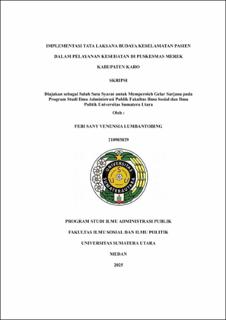| dc.description.abstract | The quality of healthcare services and patient protection represents a value system and social orientation that demands better service delivery. In response to the challenge of gradually improving service quality, the Patient Safety Program has been implemented. However, this program cannot function effectively without the implementation of a patient safety culture. Culture serves as the foundation that ensures every policy, procedure, and safety-related action is carried out consciously, consistently, and sustainably by all elements of the healthcare service. Each stage of the patient safety program must be aligned with the values of patient safety culture to enhance service quality and performance. Nevertheless, in its implementation, several challenges persist: not all healthcare facilities have clear guidelines, formal internal regulations, adequate infrastructure, sufficient competency development, or sufficient resources. Therefore, this research was conducted to explore and examine the implementation of patient safety culture governance in healthcare services at Puskesmas Merek, Karo Regency. The method used in this research is descriptive qualitative approach. Data and information were collected through interviews with the staff of Puskesmas Merek, as well as through observation and documentation to address the research problems. The data analysis refers to George C. Edwards III's policy implementation theory, which includes indicators such as communication, resources, disposition, and bureaucratic structure. The dimensions of patient safety culture analyzed include openness, reporting, justice, and learning. The findings indicate that the implementation of a patient safety culture at Puskesmas Merek has not been fully realized. In terms of communication, consistency and dissemination of information remain limited. Resource-wise, there is a shortage of personnel who fully understand the values of patient safety. Disposition reflects the willingness to implement the culture, but this is constrained by workload and a lack of training. The bureaucratic structure supports task distribution, yet it does not fully encourage a culture of incident reporting and learning. Improvements are needed through training, more flexible reporting systems, and stronger institutional support to foster a sustainable safety culture. | en_US |


